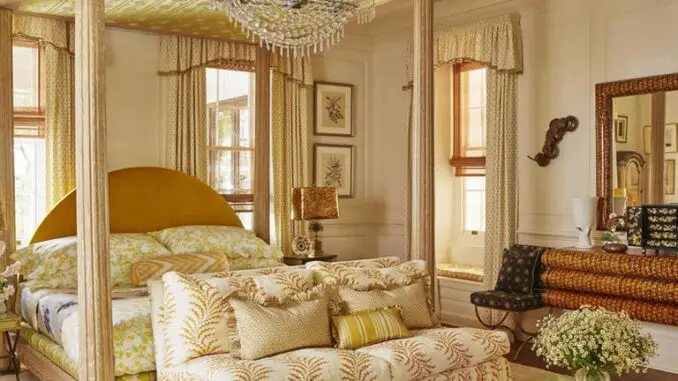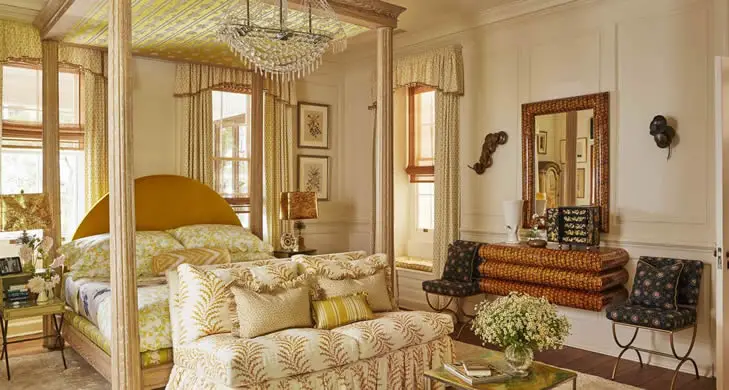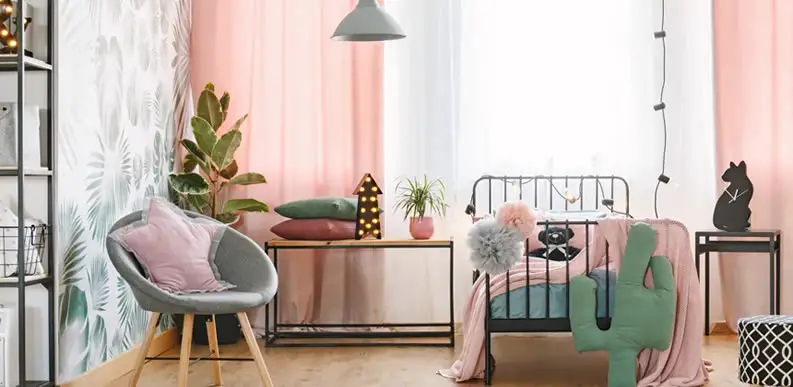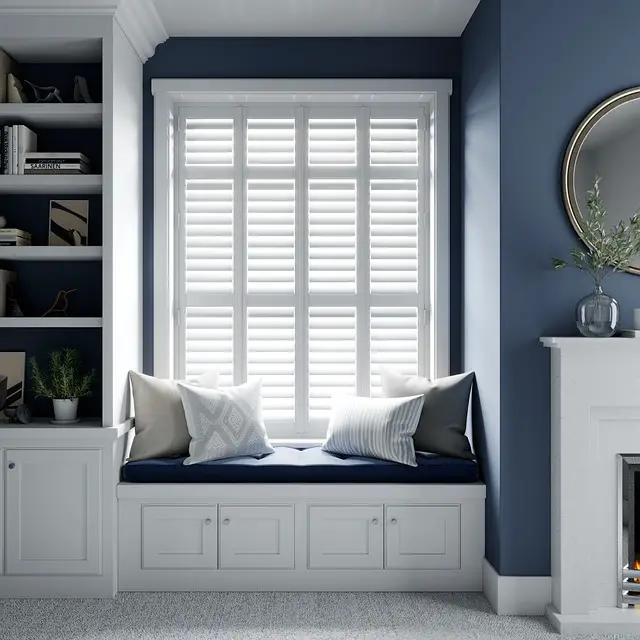
Here are 5 tips (and an additional killer tip) for kitting out your bedroom.
Contents
1. Choose a Relaxing Color Scheme
Selecting the right color scheme for your bedroom is a pivotal step in creating a peaceful and inviting atmosphere. A relaxing color palette can significantly impact your mood and overall well-being.
Here’s why it matters and how to do it:
The Psychology of Color: Different colors evoke distinct emotional responses. For a calming bedroom, opt for hues that promote relaxation. Soft blues, gentle greens, soothing grays, and warm earthy neutrals are ideal choices. These colors create a sense of serenity and tranquility, helping you unwind after a long day.
Balance and Harmony: Consider the balance of colors within your space. Use a primary color for the walls and larger surfaces, then incorporate complementary or analogous shades for accents like bedding, curtains, and décor items. This harmonious color scheme creates visual balance and a cohesive look.
Personal Preference: Ultimately, choose colors that resonate with your personal taste and preferences. Your bedroom should reflect your personality and make you feel comfortable. Consider any specific colors that have a calming or nostalgic effect on you.
Test Samples: Before committing to a color, test paint samples on a small section of your wall to see how they appear in different lighting conditions throughout the day. Colors can appear differently in natural and artificial light.
By carefully selecting a relaxing color scheme, you can set the tone for your bedroom and create a space that promotes tranquility and restful sleep.
This foundational step can make a significant difference in your overall bedroom décor and your ability to relax and unwind in your personal sanctuary.
2. Choose a Relaxing Color Scheme
Selecting the right color scheme for your bedroom is a pivotal step in creating a peaceful and inviting atmosphere.
A relaxing color palette can significantly impact your mood and overall well-being.
Here’s why it matters and how to do it:
The Psychology of Color: Different colors evoke distinct emotional responses. For a calming bedroom, opt for hues that promote relaxation. Soft blues, gentle greens, soothing grays, and warm earthy neutrals are ideal choices. These colors create a sense of serenity and tranquility, helping you unwind after a long day.
Balance and Harmony: Consider the balance of colors within your space. Use a primary color for the walls and larger surfaces, then incorporate complementary or analogous shades for accents like bedding, curtains, and décor items. This harmonious color scheme creates visual balance and a cohesive look.

Personal Preference: Ultimately, choose colors that resonate with your personal taste and preferences. Your bedroom should reflect your personality and make you feel comfortable. Consider any specific colors that have a calming or nostalgic effect on you.
Test Samples: Before committing to a color, test paint samples on a small section of your wall to see how they appear in different lighting conditions throughout the day. Colors can appear differently in natural and artificial light.
By carefully selecting a relaxing color scheme, you can set the tone for your bedroom and create a space that promotes tranquility and restful sleep.
This foundational step can make a significant difference in your overall bedroom décor and your ability to relax and unwind in your personal sanctuary.
3. Use Dimmer Switches or Smart Bulbs
Effective bedroom lighting is a crucial element in creating a relaxing and functional sleep space.
Dimmer switches and smart bulbs offer versatile lighting options that can enhance your bedroom’s ambiance and cater to your specific needs:
Adjustable Brightness: Dimmer switches and smart bulbs allow you to adjust the brightness of your bedroom lighting to suit different activities and moods. You can have bright, well-lit lighting for tasks like reading or getting dressed, and then lower the intensity for a calming, cozy atmosphere in the evening.
Circadian Rhythm Support: Some smart bulbs are designed to mimic natural daylight and adjust their color temperature throughout the day. This supports your body’s circadian rhythm by providing energizing, cooler light in the morning and warm, relaxing light in the evening, helping regulate your sleep-wake cycle.
Convenience: With smart bulbs, you can control your bedroom lighting remotely using your smartphone or voice commands, making it easy to adjust the lighting without leaving your bed. This convenience is particularly helpful when you want to create a specific ambiance or set the mood for relaxation.
Energy Efficiency: Dimmer switches and many smart bulbs are energy-efficient, allowing you to reduce energy consumption and lower your electricity bills. You can also set timers or schedules to ensure lights are not left on unnecessarily.
Personalization: Customize your bedroom lighting to your liking. Experiment with different color temperatures and brightness levels to find what helps you relax and unwind best.
By incorporating dimmer switches or smart bulbs into your bedroom lighting design, you gain greater control over your sleep environment.
These lighting options can improve your sleep quality, create a cozy atmosphere, and enhance the overall functionality and aesthetics of your bedroom.
4. Personalize Your Décor
Turning your bedroom into a truly personal sanctuary involves infusing your unique personality and style into the décor.
Personal touches not only make your space feel more inviting but also foster a sense of belonging and relaxation.
Here’s how to personalize your bedroom décor effectively:
Artwork and Photos: Adorn your bedroom walls with artwork, photographs, or prints that resonate with you emotionally. Family photos, vacation snapshots, or art pieces that evoke positive feelings can create a strong sense of connection to your space.
Decorative Elements: Incorporate décor items that reflect your hobbies, interests, or cultural background. Whether it’s vintage trinkets, travel souvenirs, or handcrafted items, these pieces add character and warmth to your bedroom.
Color Choices: The colors you choose for your bedding, curtains, and décor should align with your personal preferences. Opt for shades that make you feel comfortable and happy, whether that’s calming blues, vibrant reds, or earthy tones.

Customization: Consider customizing décor elements, such as personalized throw pillows, monogrammed linens, or a DIY headboard. These unique additions can make your bedroom feel truly one-of-a-kind.
Textiles and Fabrics: Experiment with different textures and fabrics that appeal to your senses. Soft, plush materials like velvet or faux fur can add a luxurious feel, while natural materials like wood and linen contribute to a cozy atmosphere.
Express Your Creativity: Don’t be afraid to get creative with DIY décor projects. Hand-painted furniture, handmade wall art, or repurposed items can add a personal touch and a sense of accomplishment.
Meaningful Décor: Choose décor items with personal significance, such as heirlooms, heirloom furniture, or items that have sentimental value. These pieces tell a story and create a more meaningful connection to your bedroom.
By personalizing your décor, you not only create a space that is uniquely yours but also surround yourself with elements that bring joy and comfort.
A personalized bedroom enhances your overall well-being, making it a haven where you can relax, recharge, and truly be yourself.
5. Choose Functional Furniture
Selecting furniture that not only complements your bedroom’s aesthetic but also serves practical purposes is essential for creating a comfortable and organized sleep space.
Functional furniture enhances the overall functionality of your room while optimizing storage and utility.
Here’s how to make wise choices when it comes to bedroom furniture:
Bed Selection: Start with the bed—the centerpiece of your bedroom. Opt for a mattress and bed frame that offer adequate support and comfort based on your sleep preferences. Consider storage beds with built-in drawers or under-bed space to maximize storage.
Nightstands: Choose nightstands with storage features like drawers or shelves to keep essential items within arm’s reach. These can include books, a glass of water, or bedtime essentials.
Wardrobe or Dresser: Invest in a wardrobe or dresser that provides ample storage for clothing and accessories. Consider your storage needs and available space when selecting these pieces. Look for options with compartments, hangers, or adjustable shelves to accommodate different items.
Multifunctional Furniture: Explore furniture pieces that can serve multiple functions. A bedroom bench with storage can double as a seating area and a place to store extra bedding. Folding desks or wall-mounted desks can serve as workstations and save space.
Under-Bed Storage: If space is limited, utilize under-bed storage solutions like rolling bins or storage boxes. These are ideal for seasonal clothing, extra bedding, or shoes.
Invest in Quality: Quality furniture not only lasts longer but also enhances the overall aesthetic of your bedroom. Well-made pieces can become timeless additions to your decor.
Consider Scale: Ensure that your furniture fits comfortably within the dimensions of your room without overcrowding. Maintain a sense of balance and proportion to create an aesthetically pleasing layout.
Ergonomics: If you have specific ergonomic needs, such as a desk for work or a chair for reading, prioritize comfort and functionality when selecting these items.
Choosing functional furniture for your bedroom contributes to an organized and efficient space where you can relax and unwind.
Thoughtful selections enhance the room’s overall design while meeting your practical needs, resulting in a well-rounded and comfortable sleep environment.
Additional Tip: Create a Cozy Reading Nook
A cozy reading nook within your bedroom offers a delightful escape for relaxation and introspection.
Whether you’re an avid reader or simply seeking a tranquil corner to unwind, a well-designed reading nook can enhance your bedroom’s ambiance and functionality.

Here’s how to create a cozy reading nook:
Select a Nook Location: Identify a suitable corner, window seat, or alcove in your bedroom where you can establish your reading nook. Ensure it receives ample natural light during the day for an inviting atmosphere.
Comfortable Seating: Choose seating that encourages relaxation, such as a comfortable armchair, chaise lounge, or cushioned window bench. Ensure it’s ergonomically designed to provide support during extended reading sessions.
Good Lighting: Proper lighting is crucial for reading. Incorporate a reading lamp or pendant light directly over your reading nook. Opt for adjustable lighting to control brightness and minimize glare.
Cozy Textiles: Layer your reading nook with plush textiles. Add soft cushions, throw blankets, and decorative pillows for extra comfort. Consider incorporating fabrics and colors that complement your bedroom decor.
Storage Solutions: Install shelving or bookcases nearby to keep your favorite books within easy reach. You can also use these storage spaces to display decorative items or personal mementos.
Personal Touches: Infuse your reading nook with personal touches like artwork, inspirational quotes, or small decor items that resonate with your interests and passions.
Quiet Retreat: Ensure your reading nook is a quiet retreat. Use noise-absorbing materials or rugs to minimize sound disturbance from the rest of the room.
Aromatherapy: Add a touch of aromatherapy with scented candles or essential oil diffusers to create a sensory experience that enhances relaxation.
Privacy and Tranquility: Consider using curtains or screens to create a sense of privacy and separation within your bedroom, making the nook feel like a secluded retreat.
By creating a cozy reading nook in your bedroom, you establish a dedicated space for relaxation and personal reflection.
It becomes a haven where you can escape into the pages of a good book, unwind, and recharge, adding depth and character to your sleep space.
